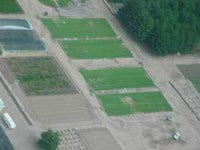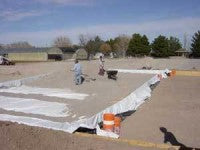Irrigation Study by USGA
Irrigation Study by USGA
Effect of Greens Type, Irrigation Type, and Root Zone Material on Irrigation Efficiency, Turfgrass Quality and Water Use on Putting Greens in the Southwest (USA)
By Bernd Leinauer and Jose Makk, New Mexico State University
Objectives:
1. To study the effects of different irrigation systems on turf quality, drought resistance, and irrigation efficiency in greens with a sloping design.
2. To study the effects of rootzone materials (sand, sand-peat mix, and sand- urea-formaldehyde polymer mix) on creeping bentgrass establishment, turf quality, and soil moisture retention in a sloped putting green.
Start Date: 2002
Project Duration: 3 years
Total Funding: $90,000
Sprinkler irrigation has been the accepted practice for irrigating lawns since Joseph Smith patented the first swiveling lawn sprinkler in 1894, despite its low efficiency in distributing water to the plant stand. Sprinkler overlap, wind drift, and evaporation losses during the irrigation process all contribute to water losses that increase overall water consumption and/or decrease plant stand quality.
Subirrigation systems that apply water laterally to the root zone from perforated tiles or emitters buried either close to the surface or just below the normal root penetration from beneath the surface (subsurface drip irrigation or subirrigation). These systems have been proven to potentially save substantial quantities of irrigation water compared to sprinkler systems. Although the benefits of subsurface irrigation have been extensively studied in agriculture, subsurface irrigation has received very little acceptance or attention in the field of turf irrigation, despite strong evidence of its potential water savings. In addition to water savings, other advantages of subirrigation systems include the improved distribution uniformity (no wind drift or runoff), uninterrupted use of the turf area during irrigation, and energy savings due to a lower operating pressure.

|

|
| Aerial view of the irrigation research plots at the Fabian Garcia Research Center at New Mexico State University. |
Irrigation research plots were built to study the impact of irrigation type (sprinkler vs. subsurface drip irrigation vs. subirrigation) and type of rootzone mix (straight sand vs. sand mixed with peat vs. sand mixed with urea-formaldehyde polymer) on irrigation efficiency and turfgrass performance of 'Bengal' creeping bentgrass.
|
Highly trafficked and low cut grass stands, which include athletic fields and greens and tees on golf courses, are usually built with either sand alone (California style) or with a sandy root zone mix (USGA style). Because of this coarse texture, these root zones resist compaction, provide high air filled porosity, but lack in adequate water retention. To increase water-holding capacity, USGA style root zones are usually amended with peat. To date, peat is the only recommended organic amendment for root zone construction. However, during recent years, peat has become increasingly scarce, as bogs become more and more restricted for harvesting peat. Inorganic amendments, such as urea-formaldehyde polymers, could provide a viable alternative to organic amendments for the use in sandy root zones.
A 4000 m2 (43,000 ft2) research area was built at the Fabian Garcia Research Center at New Mexico State University to study the impact of irrigation type (sprinkler vs. subsurface drip irrigation vs. subirrigation) and type of root zone mix (straight sand vs. sand mixed with peat vs. sand mixed with urea-formaldehyde polymer) on irrigation efficiency and turfgrass performance of Bengal creeping bentgrass. Each of the 12 research greens measures 17 m x 17 m (55' x 55') and includes a 5% south facing slope. The greens were seeded on May 16, 2003 and visual establishment ratings were taken at bi-weekly intervals. Because of the late seeding date and the record heat during establishment, all plots received light watering from sprinklers several times per day in addition to scheduled irrigation.
Overall statistical analysis of establishment data revealed no significant differences between treatment effects. When data were analyzed separately for each sampling date, USGA built-sprinkler irrigated greens established the fastest and USGA built-subsurface drip irrigated greens established the slowest. On the first 2 sampling dates differences in rate of establishment were significantly different at the 99.9% probability level. Regardless of construction and irrigation type, straight sand plots were the slowest to establish, followed by urea-formaldehyde polymer amended sand. Of all 3 amendments tested, peat-amended plots were the quickest to establish.
Summary Points:
-
Studies are underway at New Mexico State University to compare sprinkler versus subsurface drip versus subground irrigation for putting greens.
-
Studies are also comparing type of rootzone mix (straight sand versus sand mixed with peat versus sand mixed with urea-formaldehyde polymer) on irrigation efficiency.
-
At the beginning of the establishment period, peat-amended plots grew in the quickest. At the end of the three-month establishment period, urea-formaldehyde.polymer amended plots reached coverage equal to that of peat-amended plots.
-
All plots, including sub-irrigated ones, needed additional light watering from sprinklers during the day in addition to scheduled irrigation to prevent drought stress.
-
Despite having received the least total amount of irrigation water, coverage on subground irrigated plots was either highest or second highest.
2003 USGA Turfgrass and Environmental Research summary.
Reproduced with kind permission of USGA Turfgrass and Environmental Research Program.
For further information you can visit www.usga.org
